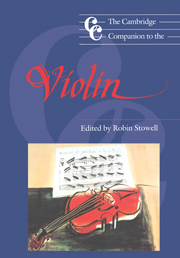Book contents
- Frontmatter
- 1 The violin and bow – origins and development
- 2 The physics of the violin
- 3 The violinists of the Baroque and Classical periods
- 4 The nineteenth-century bravura tradition
- 5 The twentieth century
- 6 The fundamentals of violin playing and teaching
- 7 Technique and performing practice
- 8 Aspects of contemporary technique (with comments about Cage, Feldman, Scelsi and Babbitt)
- 9 The concerto
- 10 The sonata
- 11 Other solo repertory
- 12 The violin as ensemble instrument
- 13 The pedagogical literature
- 14 The violin – instrument of four continents
- 15 The violin in jazz
- Appendix Principal violin treatises
- Glossary of technical terms
- Notes
- Select bibliography
- Index
2 - The physics of the violin
Published online by Cambridge University Press: 28 September 2011
- Frontmatter
- 1 The violin and bow – origins and development
- 2 The physics of the violin
- 3 The violinists of the Baroque and Classical periods
- 4 The nineteenth-century bravura tradition
- 5 The twentieth century
- 6 The fundamentals of violin playing and teaching
- 7 Technique and performing practice
- 8 Aspects of contemporary technique (with comments about Cage, Feldman, Scelsi and Babbitt)
- 9 The concerto
- 10 The sonata
- 11 Other solo repertory
- 12 The violin as ensemble instrument
- 13 The pedagogical literature
- 14 The violin – instrument of four continents
- 15 The violin in jazz
- Appendix Principal violin treatises
- Glossary of technical terms
- Notes
- Select bibliography
- Index
Summary
Introduction
A study of the physics of the violin gives a fascinating insight into how the instrument converts the player's intricate motions into musical sounds. Practising musicians are often blissfully unaware of the ways in which their instruments function, but a basic understanding of the mechanics involved can be of great benefit when teaching, selecting instruments or dealing with minor problems. It also brings a little more objectivity to a subject otherwise clouded with myth, mystique and superstition.
The twentieth century has witnessed a great increase in the scientific evaluation and development of a wide range of musical instruments. Occasionally, investigations are designed specifically to improve the performance of instruments or to achieve greater control during their manufacture. Some of these studies have been successful. More usually, they are carried out purely for the sake of curiosity – a desire to seek a rational explanation of an observed phenomenon. The researcher now has a wide range of powerful analytical techniques at his disposal. For example, he can use sensitive electronic instrumentation, high-speed computers and even lasers to probe the tiny vibrations of the violin. Although these physical studies have demonstrated the basic action of the violin and unravelled a few of its 'mysteries', they are still far from answering those tantalising questions relating to the finer details of violin tone.
- Type
- Chapter
- Information
- The Cambridge Companion to the Violin , pp. 30 - 45Publisher: Cambridge University PressPrint publication year: 1992
- 2
- Cited by



